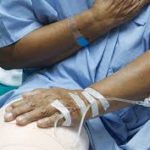 Do you think one person can survive 4 different infectious diseases, all occurring in the space of just 5 weeks? Certainly they can! But it definitely takes a lot of will power on the part of the patient, a supportive family, and of course, a competent team of doctors, nurses, physical therapists, etc.
Do you think one person can survive 4 different infectious diseases, all occurring in the space of just 5 weeks? Certainly they can! But it definitely takes a lot of will power on the part of the patient, a supportive family, and of course, a competent team of doctors, nurses, physical therapists, etc.
One day I got a call to see a patient who started having fever the night before. It was an elderly person in their 80s, who was completely independent until coming down with gastroenteritis 5 weeks earlier, from…guess what? Salmonella – infection #1.
Recovering from salmonella involved staying in a facility to get rehabilitation. During that time, antibiotics were given for a urinary tract infection (UTI) – infection #2.
The patient ultimately improved to the point of getting discharged home.
Lo and behold, barely a day after being discharged, severe diarrhea started (again!). The patient’s family wondered if the salmonella was coming back. The diarrhea was so bad that dehydration developed and the patient ended right back in hospital.
Infection #3 was diagnosed – Clostridium difficile (C. diff). The patient hadn’t completely recovered from the recent infections (salmonella and UTI) in terms of strength etc, so this one brought back down the energy levels quite a lot.
As explained in a previous post, C. diff is a serious infection which ends up killing many patients, especially elderly ones.
Needless to say, this patient was admitted to hospital again, to treat the C. diff and dehydration. Because of persisting stomach upset, the food intake was poor. The decision was made to give special nutrition via a drip, to make up for the very poor intake by mouth. The drip was given via a large catheter in a vein (called a PICC line).
The patient was coming along nicely, building up strength and starting to eat a little more, until one night a high fever developed, with severe shivering. The following morning was when I got called to see the patient.
The patient was elderly, and obviously sick, shaking like a leaf. I was highly suspicious that the source of this shivering was an infection in the bloodstream, most likely a yeast because of the type of nutrition that was being given in the drip, but maybe bacteria.
A strong anti fungal was started, along with strong antibiotics to cover the more resistant bacteria that patients often ‘catch’ while in hospital. The cultures subsequently came back positive for yeast (Candida) in the blood – infection #4. The yeast, most likely, first infected the catheter (PICC line) being used to give the nutrition in the vein. From the catheter, the yeast spread into the blood stream. The PICC line had to be removed urgently.
The antibiotics were stopped and the patient was kept on the anti fungal medication only, for this last infection. Needless to say, the family members were very concerned, and had numerous questions, including…
– Have you any idea what’s wrong? Yes, and I outlined the above to them
– Can we cure this infection? Yes, certainly
– Will the patient get better? Only time will tell. Each patient tolerates infections differently. Given the age of this patient, and the fact that the body has already been run down by 3 recent infections, in just the past month, it is possible that this infection will end up being too overwhelming and the patient could possibly succumb to it. But I warned the family, that they needed to provide strong support and encouragement. I also tried to give the patient hope that what we were dealing with was totally treatable, but that they would have to have to will to carry on.
I have learned that a person’s will to live has a lot to do with whether or not they survive a severe illness.
Fortunately in this case, the patient made steady (though initially slow) progress. Activity level increased, regular food intake increased, and the patient was able to be discharged, almost 8 weeks after first becoming ill with salmonella. I should note that in this patient’s favor, was that fact that they were quite healthy, independent, and active, before onset of the salmonella.
Could any of these infections have been prevented in this patient? Possibly, but hindsight is 20/20.
Lessons learned/takeaway points:
1 – beware the food you eat, where you get it, how it is prepared
2 – be cognizant of how long you take antibiotics for. Too often, people are treated for longer than they really need to be, for simple infections such as UTIs, and that increases their risk of coming down with C. diff and other complications. (I am usually stingy with prescribing antibiotics, but I admit to occasionally being guilty of treating patients for too long.)
3 – consider getting your rehabilitation at home. The fact is, being in any health care setting increases your chance of coming into contact with more harmful, resistant germs. The longer you stay in such settings, the higher the chance of eventually picking up an infection, such as C. diff.
4 – getting nutrition the natural way means less complications. Let’s face it, natural is always better than artificial. Yes, it’s hard to see a loved one not eating as you think they should, but continued encouragement and support can help to gradually increase intake.
Leave a Reply